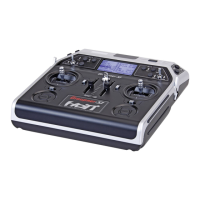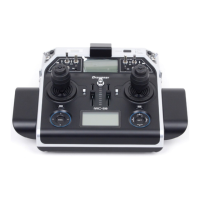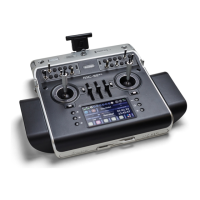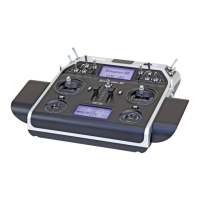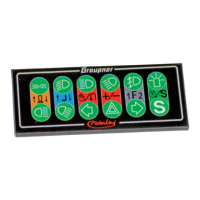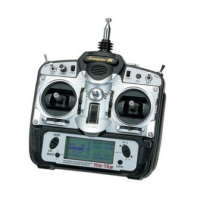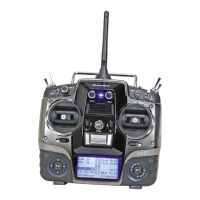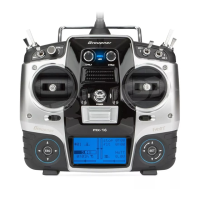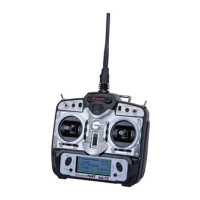200
General notes on freely programmable mixers
The previous pages have described a wealth of ready-
to-use built-in coupling functions, in the context of the
two menus »Wing mixers« and »Helicopter mixers«.
The fundamental significance of mixers and the princi-
ple by which they work are described on page 165.
The following section provides information about the
so-called “free mixers”.
In addition to the pre-programmed mixers mentioned
above, the transmitters
mc-16 HoTT and mc-20
HoTT also offers a number of freely programmable
mixers in every model memory location, whose inputs,
outputs and mixer ratios can be defined to meet one’s
own requirements. These include:
• 8 linear mixers, numbered 1 through 8
• 4 curve mixers, numbered 9 through 12
These 12 mixers are certainly adequate for most ap-
plications and are certainly sufficient when the potential
of the pre-programmed coupling functions are utilized.
The »MIX act. / phase« menu, which is available as
standard on the
mc-20 HoTT transmitter only, see
page 211, also provides a means of activating or
disabling any of these twelve mixers separately for
each flight phase.
For the “free mixers”, the signal present at any control
function (1 to 8 or 1 … 12) can be assigned as the
input signal or, for a so-called “switch channel” (see
further below), the signal from any switch can be uti-
lized. The signal that is present at the control channel
and passed to the mixer input is always influenced by
its own transmitter control and by any control charac-
teristic that may have been set, e. g. those specified
by the »Dual Rate / Expo«, »Channel 1 curve« and
»Control adjust« menus.
The mixer output acts on a control channel (1 to – de-
pending on transmitter and receiver type – a maximum
of 12) that can also be assigned freely.
Before this channel routes the signal to the servo, it
can only still be influenced by the »Servo adjustment«
menu, i. e. by the servo reverse, neutral point offset,
servo travel and servo travel limit functions, and pos-
sibly by the »Tx. output swap« option, which is availa-
ble as standard on the
mc-20 HoTT transmitter only.
One control function can be used for any number of
mix inputs simultaneously: if, for example, several mix-
ers are to be switched to act in parallel.
Conversely, it is possible for any number of mixers to
affect one and the same control channel. Particularly in
the latter case, however, it is very important to ensure
that the servo concerned does not strike its mechani-
cal end-stops when several mixer signals accumulate
excessively. For safety’s sake, it may therefore be nec-
essary to set an appropriate travel limit in the »Servo
adjustment« menu, page 106.
For more complex applications, mixers can be
switched in sequence. In this case, it is not the (trans-
mitter) signal at the “output” of a control function which
forms the input signal of the “series-wired” mixer, but
the (mixed) signal “further back” at the “input” of a
control channel. The following description of the free
mixers includes several examples of this type.
In the software, a “free mixer” is always initially acti-
vated. Optionally the mixer can also be assigned to an
ON/OFF switch. Since there are so many functions to
which switches can be assigned, be careful to avoid
(undesired) multiple assignments to a single switch.
The two key mixer parameters are:
• … the mixer ratio, which defines the extent to
which the input signal acts on the output of the
control channel connected to the mixer output.
The mixer ratio for linear mixers can be set as sym-
metrical or asymmetric.
Curve mixers can also be configured with up to 6
points to suit one’s own application and even imple-
ment extremely non-linear curves.
• … the neutral point of a mixer, which is also re-
ferred to as the “offset”.
The offset is that specific point along the movement
of a transmitter control (stick, proportional control or
switch) at which the mixer no longer influences the
control channel connected to its output. Normal-
ly, the neutral point is the centre point of the trans-
mitter control. However, the offset can also be set at
any other point along the control travel. Since there
are no restrictions on the design of the curve mix-
ers, setting a mixer neutral point only makes sense
for the 8 linear mixers.
Switch channel “S” as a mixer input
Occasionally, however, only a constant control signal
is required at the mixer output, e. g. for a slightly in-
creased “up-elevator” trim when the aero-tow release
is closed – fully independently of its normal trim setting.
In this case a switch is assigned both to the aero-tow
release and the mixer; it is then used not only to open
and close the release, but also to pass the desired trim
signal to the elevator via the mixer ratio. To identify this
special arrangement, this mixer input control function in
the program is designated “S” for “Switch channel”.
In addition, if the corresponding “target channel”
should now no longer be influenced by its “normal”
transmitter control, separate its transmitter control from
the function input of the associated control channel
in the »Mix-only channel«, see page 212, which is
available as standard on the
mc-20 HoTT transmit-
ter only. Here too, for clarification of this there is an
example of the function provided in the following menu
description.
General notes on freely programmable mixers
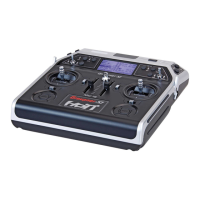
